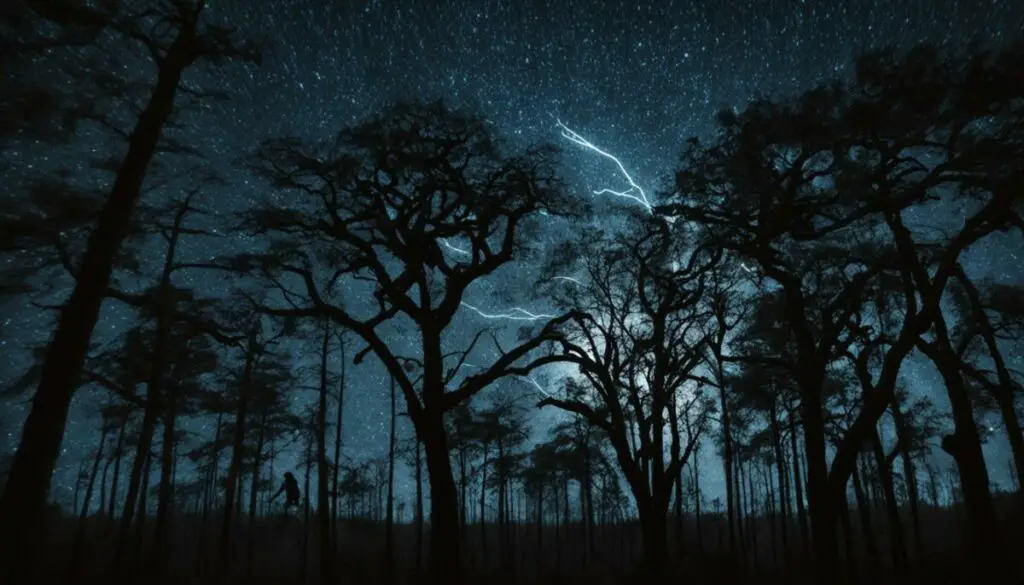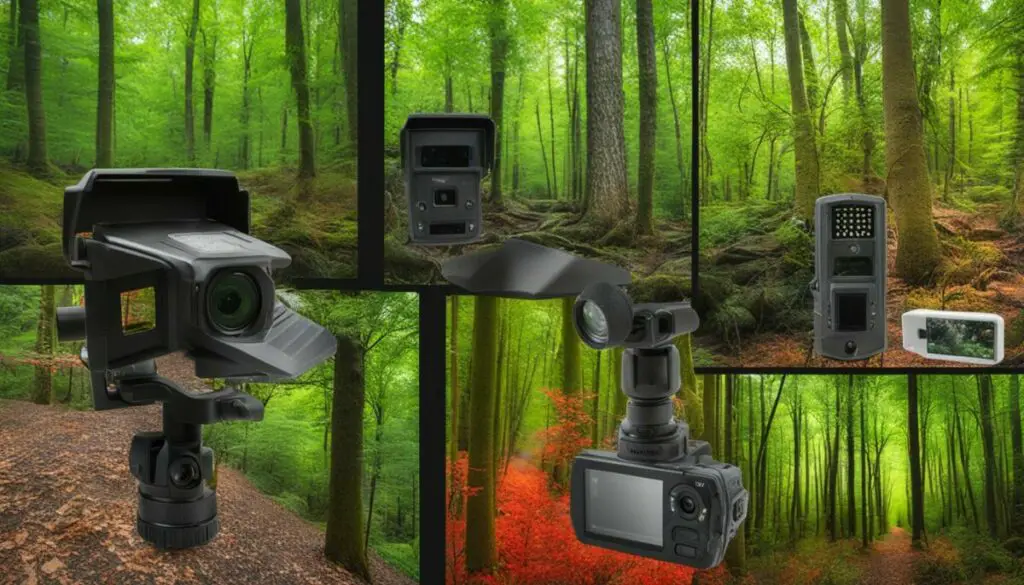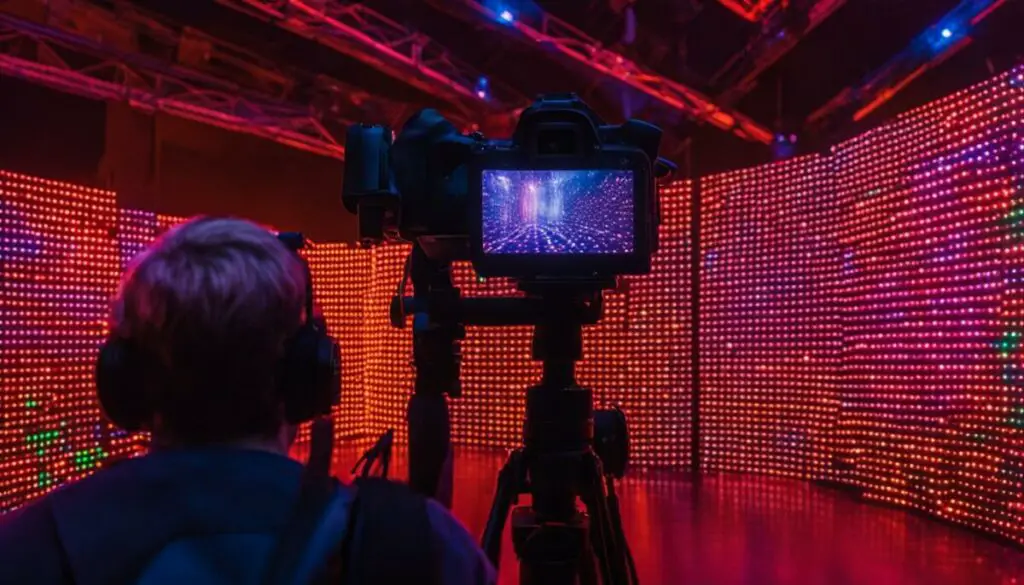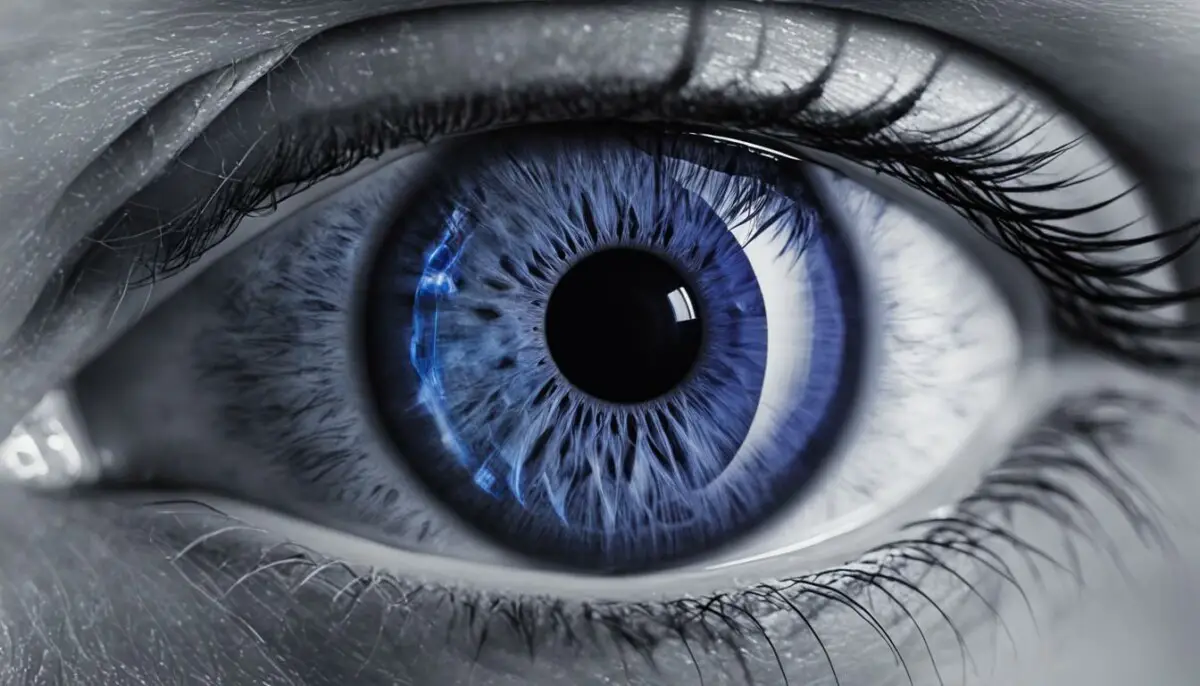Last Updated on 4 months by Francis
If you’ve ever wondered whether humans can see the flash from infrared trail cameras, you’re not alone. Infrared flash trail cameras use advanced technology to capture images and videos in low-light conditions or complete darkness. But can the human eye detect the invisible infrared light emitted by these cameras?
The answer is no. The infrared flash emitted by trail cameras is outside the visible spectrum for humans, making it completely invisible to the naked eye. While animals with specialized vision may be able to perceive the infrared flash, humans simply do not have the ability to detect infrared light in the same way.
But why is this the case? Our eyes are designed to perceive a narrow range of electromagnetic radiation known as the visible light spectrum, which includes colors ranging from red to violet. Infrared light has a longer wavelength than red light, which means it falls outside the range of what humans can see.
So, while trail cameras use infrared technology to capture clear images and videos in low-light conditions, humans cannot see the flash. This makes infrared flash trail cameras a discreet and effective tool for wildlife monitoring, security surveillance, and outdoor photography.
Contents
Key Takeaways:
- Humans cannot see the infrared flash emitted by trail cameras.
- Infrared light has a longer wavelength than visible light, making it invisible to the naked eye.
- Trail cameras use infrared technology to capture clear images and videos in low-light conditions.
- Animals with specialized vision may be able to perceive the infrared flash.
- Infrared flash trail cameras are widely used for wildlife monitoring, security surveillance, and outdoor photography.
Understanding the limitations of human perception and the capabilities of trail camera technology is crucial for utilizing these powerful tools effectively. Although we can’t see the infrared camera flash, we can certainly appreciate the valuable insights it provides in various fields.
How Does Infrared Technology Work?

Infrared flash trail cameras utilize advanced infrared technology to capture high-quality images and videos even in challenging lighting conditions. These cameras emit infrared light, which is invisible to the human eye but can be detected by the camera’s sensor. By using this invisible light, infrared flash trail cameras can illuminate the subject and capture clear images and videos in low-light conditions or even complete darkness.
The camera sensor is a crucial component in this process. It is designed to detect the infrared light, converting it into visible images and videos that can be viewed and analyzed by users. By effectively utilizing infrared technology, these cameras have revolutionized the way we capture moments in environments with limited visible light.
One of the key advantages of infrared technology is its ability to perform in low-light conditions where conventional cameras would struggle. Whether it’s capturing wildlife in a dimly lit forest or monitoring a secluded area during the night, infrared flash trail cameras excel in providing high-quality footage without the need for external lighting sources. This makes them an ideal choice for wildlife enthusiasts, security surveillance, and outdoor photography.
By harnessing invisible light, infrared flash trail cameras open up new possibilities for capturing moments that would otherwise go unseen.
The use of infrared technology in these cameras allows them to capture images and videos in complete darkness, where even the human eye may struggle to perceive objects. This is achieved by relying on the camera’s ability to detect the infrared light reflected or emitted by the subjects, even in the absence of any visible light sources. As a result, infrared flash trail cameras provide a unique perspective on the hidden world of low-light environments.
With the rapid advancements in infrared technology, these cameras continue to evolve, delivering improved image quality, extended range, and enhanced performance in challenging conditions. They have become indispensable tools for researchers, photographers, and wildlife enthusiasts, offering valuable insights and opening up new frontiers in our understanding and observation of the natural world.
Types of Flash in Trail Cameras

When it comes to trail cameras, the type of flash used can greatly impact their performance and effectiveness. Let’s explore the three main types of flash in trail cameras: white flash, red flash, and black flash.
White Flash
White flash cameras emit a visible flash of light when capturing images or videos. This flash can startle animals and potentially scare them away, making white flash cameras less desirable for certain applications. However, they do produce color images and videos with excellent clarity and detail.
Red Flash
Red flash cameras use infrared light with a wavelength between 625nm and 750nm. This type of flash is less noticeable to animals compared to white flash. The red flash allows for discreet capturing of images and videos without spooking wildlife. While the images and videos captured by red flash cameras are in black and white, they still provide clear visibility.
Black Flash
Black flash cameras, also known as invisible flash or no glow cameras, use infrared light with a wavelength of 940nm. This wavelength is beyond the visible spectrum for humans and most mammals, making the flash invisible to the naked eye. These cameras are designed to capture images without alerting or spooking animals, making them ideal for wildlife monitoring and surveillance purposes. The images and videos captured by black flash cameras are in black and white.
Here is a table summarizing the differences between the three types of flash:
| Type of Flash | Visibility | Color Capability | Spooking Wildlife |
|---|---|---|---|
| White Flash | Visible to animals and humans | Color images and videos | Potential spooking effect |
| Red Flash | Less noticeable to animals | Black and white images and videos | Discreet capturing |
| Black Flash | Invisible to animals and humans | Black and white images and videos | No spooking effect |
As you can see, each type of flash has its advantages and disadvantages depending on the intended use and purpose. It’s essential to consider these factors when choosing a trail camera to ensure optimal results for your specific needs.
Can Humans See the Flash from Black Flash Cameras?

No, humans cannot see the flash from black flash cameras. The flash emitted by these cameras is in the infrared spectrum, which is beyond the UV spectrum and invisible to the human eye. The human eye is not sensitive to light with a wavelength of 940nm, which is the wavelength at which black flash cameras operate. While animals with nocturnal vision, such as certain amphibians and reptiles, may be able to detect the flash, humans cannot perceive it.
Black flash cameras are specifically designed to be less visible and not alert or spook animals when capturing images or videos in low-light conditions or complete darkness. By emitting light in the infrared spectrum, these cameras are able to operate without disturbing the natural behavior of wildlife.
This technology proves to be highly advantageous in wildlife monitoring, security surveillance, and outdoor photography, as it allows for discreet and effective image capturing without causing any disruption to the environment or the subjects being observed.
As shown in the image above, the black flash emitted by these cameras falls beyond the UV spectrum and remains invisible to the human eye. This ensures that the subjects being observed are not disturbed by any visible light or apparent flash.
Factors Affecting Flash Visibility
Flash visibility in trail cameras can be influenced by several factors that determine how well the flash is perceived. These factors include camera range, infrared flash quality, camera sensitivity, animal size, and terrain.
Camera Range: The range of the camera’s flash plays a crucial role in flash visibility. Different camera models have varying flash ranges, which can range from just a few feet to over 100 feet. It’s essential to select a camera with a flash range that suits your specific needs to ensure optimal visibility.
Infrared Flash Quality: The quality of the infrared flash also affects its visibility. Factors such as intensity and range can significantly impact how well the flash is perceived by the camera’s sensor. Higher-quality infrared flashes tend to have better visibility in different lighting conditions, resulting in clearer images and videos.
Camera Sensitivity: The sensitivity of the camera’s sensor plays a significant role in flash visibility. A more sensitive sensor can detect even subtle variations in light, resulting in better visibility of the flash. When choosing a trail camera, consider the sensor’s sensitivity to ensure optimal flash visibility.
Animal Size: The size of the animal being captured can also affect flash visibility. Larger animals may require a more powerful flash to be clearly visible. Conversely, smaller animals may have a lower threshold for detecting the flash. Consider the size of the wildlife you intend to capture to ensure adequate flash visibility.
Terrain: The terrain in which the camera is placed can also impact flash visibility. Obstructions such as dense vegetation or objects in the foreground can obstruct the path of the flash, potentially reducing its visibility. Consider the topography and surrounding environment when setting up your trail camera for optimal flash visibility.
“Choosing a trail camera with sufficient flash range, high-quality infrared flash, and a sensitive sensor is essential for achieving optimal flash visibility. Additionally, considering the size of the wildlife and the terrain in which the camera is placed can further enhance the visibility of the flash.”
| Factors Affecting Flash Visibility | Description |
|---|---|
| Camera Range | Range of the camera’s flash (few feet to over 100 feet) |
| Infrared Flash Quality | Intensity and range of the infrared flash |
| Camera Sensitivity | Sensitivity of the camera’s sensor |
| Animal Size | Size of the animal being captured |
| Terrain | Obstructions and surroundings that affect flash visibility |
Detecting Infrared Light at Home

Are you curious about detecting infrared light at home? It’s easier than you might think! With just a remote control and a video recording device, such as a smartphone or camera, you can uncover the invisible world of infrared light. Let’s explore how.
The first step is to understand that remote controls emit infrared light when a button is pressed. While this light is invisible to the naked eye, we can still detect it using a video recording device. By focusing on the top light bulb of the remote control and recording a video, we can capture a small flash of light whenever a button is pressed. This flash represents the infrared light emitted by the remote control.
“The invisible becomes visible through the lens of technology.”
This simple experiment highlights the invisibility of infrared light to the human eye. It’s fascinating to see how technology can unveil hidden phenomena that are otherwise beyond our perception.
To enhance your understanding, here is a step-by-step guide to detecting infrared light at home using a remote control and a video recording device:
- Ensure your video recording device is ready, whether it’s a smartphone or a camera.
- Position the video recording device in front of the remote control.
- Focus on the top light bulb of the remote control.
- Press a button on the remote control to activate the infrared light.
- Record a video while keeping your focus on the top light bulb.
- Review the recorded video to observe the small flash of light emitted by the remote control.
This fun experiment not only demonstrates the invisibility of infrared light but also showcases the power of technology in revealing hidden aspects of our world. Give it a try and witness the unseen!
Making Infrared Goggles
Have you ever wondered how to make your own infrared goggles? With just a few simple materials, you can create a pair of goggles that allow you to detect infrared light. All you need are welding goggles and stage lighting gels.
Start with a pair of welding goggles that have removable lenses. These goggles serve as the perfect base for your infrared goggles. The removable lenses allow you to insert the stage lighting gels later on.
The next step is to acquire blue and red stage lighting gels. These gels are used to block out most of the visible light spectrum, enhancing your eyes’ ability to absorb infrared light. Cut the gels to fit the size of the welding goggles and insert them into the goggles’ lens slots.
Once the stage lighting gels are securely inserted, you have successfully created your own infrared goggles. These goggles filter out visible light and enhance the detection of infrared light, allowing you to see beyond the limitations of the visible light spectrum. It’s a fun and unique way to explore the world of infrared light detection.
These homemade infrared goggles provide an exciting opportunity to experience the invisible realm of infrared light. Put them on and discover a whole new perspective!
Common Misconceptions About Infrared Flash Visibility
When it comes to infrared flash visibility, there are several common misconceptions that need to be addressed. Let’s debunk these misconceptions and gain a better understanding of how trail cameras and infrared flash work.
No Glow Cameras are Completely Invisible to Humans
Contrary to popular belief, No Glow or Black Flash cameras are not completely invisible to humans. While they are designed to minimize visibility, they are usually visible to some extent depending on the angle and proximity. The infrared flash emitted by these cameras may appear as a faint red glow, especially in close proximity or in certain lighting conditions. It’s important to understand that even though these cameras are discreet, they are not entirely invisible.
Infrared Flash Spooks Wildlife
Another misconception is that the flash from trail cameras, including infrared flash, spooks deer and other wildlife. In most cases, it is not the flash itself that spooks animals, but rather the presence of the camera. Wildlife can sense the presence of cameras through their keen senses, such as smell or hearing, rather than being frightened by the flash. It’s important to camouflage and strategically place trail cameras to minimize their impact on wildlife behavior.
Multiple Cameras Creating the Illusion of Visible Flash
Setting up multiple trail cameras in close proximity can lead to a misconception of visible flash. When one camera detects the infrared flash from another camera, it may appear as a visible flash, creating the illusion that the flash is visible to the human eye. This phenomenon is due to the interaction between the cameras and does not reflect the visibility of the flash itself. It’s essential to consider camera placement and spacing to avoid any misleading observations.
| Common Misconceptions About Infrared Flash Visibility | Status |
|---|---|
| No Glow Cameras are Completely Invisible to Humans | Not true. They may be partially visible. |
| Infrared Flash Spooks Wildlife | Not true. Wildlife is more sensitive to the presence of the camera. |
| Multiple Cameras Creating the Illusion of Visible Flash | True. Multiple cameras can create the illusion of visible flash. |
Conclusion
In conclusion, it is important to understand that humans cannot see the flash from infrared trail cameras. The wavelength of the infrared flash is beyond the visible spectrum for humans, which means it is invisible to the naked eye. Although some animals may be able to perceive the flash, humans do not possess the ability to detect infrared light in the same way.
The use of infrared flash in trail cameras has revolutionized wildlife monitoring and outdoor photography. It allows for discreet and effective capturing of images and videos in low-light conditions or complete darkness, providing valuable insights into the behavior and habits of different species without disturbing their natural environment.
It is crucial to recognize the limitations of human eyes and leverage the capabilities of trail camera technology when using and interpreting the images captured by these cameras. By understanding how infrared flash works and its invisibility to humans, we can better appreciate the remarkable advancements made in wildlife monitoring and trail camera technology.
FAQ
Can humans see the flash from infrared trail cameras?
No, humans cannot see the flash from infrared trail cameras. The infrared flash emitted by these cameras is beyond the visible spectrum for humans, making it invisible to the naked eye.
How does infrared technology work in trail cameras?
Infrared flash trail cameras use infrared technology to capture images and videos in low-light conditions or complete darkness. The camera emits infrared light, which is not visible to the human eye but can be detected by the camera’s sensor, enabling it to capture clear images and videos in dark environments.
What are the types of flash in trail cameras?
There are three types of flash in trail cameras: white flash, red flash, and black flash. White flash cameras emit a visible flash of light, while red flash cameras use infrared light that is less noticeable to animals. Black flash cameras, also known as invisible flash or no glow cameras, use infrared light beyond the visible spectrum, making them invisible to humans and most mammals.
Can humans see the flash from black flash cameras?
No, humans cannot see the flash from black flash cameras. The flash emitted by these cameras is in the infrared spectrum and is beyond the UV spectrum, which is invisible to the human eye. Humans are not sensitive to light with a wavelength of 940nm, the wavelength at which black flash cameras operate.
What factors can affect flash visibility in trail cameras?
Flash visibility in trail cameras can be affected by various factors, including the camera’s flash range, the quality of the infrared flash, the sensitivity of the camera’s sensor, the size of the animal being captured, and the terrain in which the camera is placed.
How can infrared light be detected at home?
Infrared light can be detected at home using a remote control and a video recording device, such as a smartphone or camera. By focusing on the top light bulb of the remote control and using the video recording device, you can see a small flash of light when a button is pressed, representing the infrared light emitted by the remote control.
How can I make infrared goggles to detect infrared light?
Infrared goggles can be made using welding goggles and stage lighting gels. By cutting and inserting blue and red stage lighting gels into the removable lenses of welding goggles, you can create goggles that filter out visible light and enhance the detection of infrared light.
What are some common misconceptions about infrared flash visibility?
Some common misconceptions include the belief that No Glow or Black Flash cameras are completely invisible to humans, which is not true as they are usually visible to some extent. Another misconception is that spooking wildlife can occur due to the flash from trail cameras, but often it is the presence of the camera itself that scares animals. Additionally, if multiple trail cameras are set up in close proximity, one camera may detect the flash from another camera, creating the illusion of visible flash.
What is the conclusion regarding the visibility of infrared flash to humans?
In conclusion, humans cannot see the flash from infrared trail cameras. The wavelength of the infrared flash is beyond the visible spectrum for humans, making it invisible to the naked eye. Understanding the limitations of human eyes and the capabilities of trail camera technology is essential for using and interpreting the images captured by these cameras.








